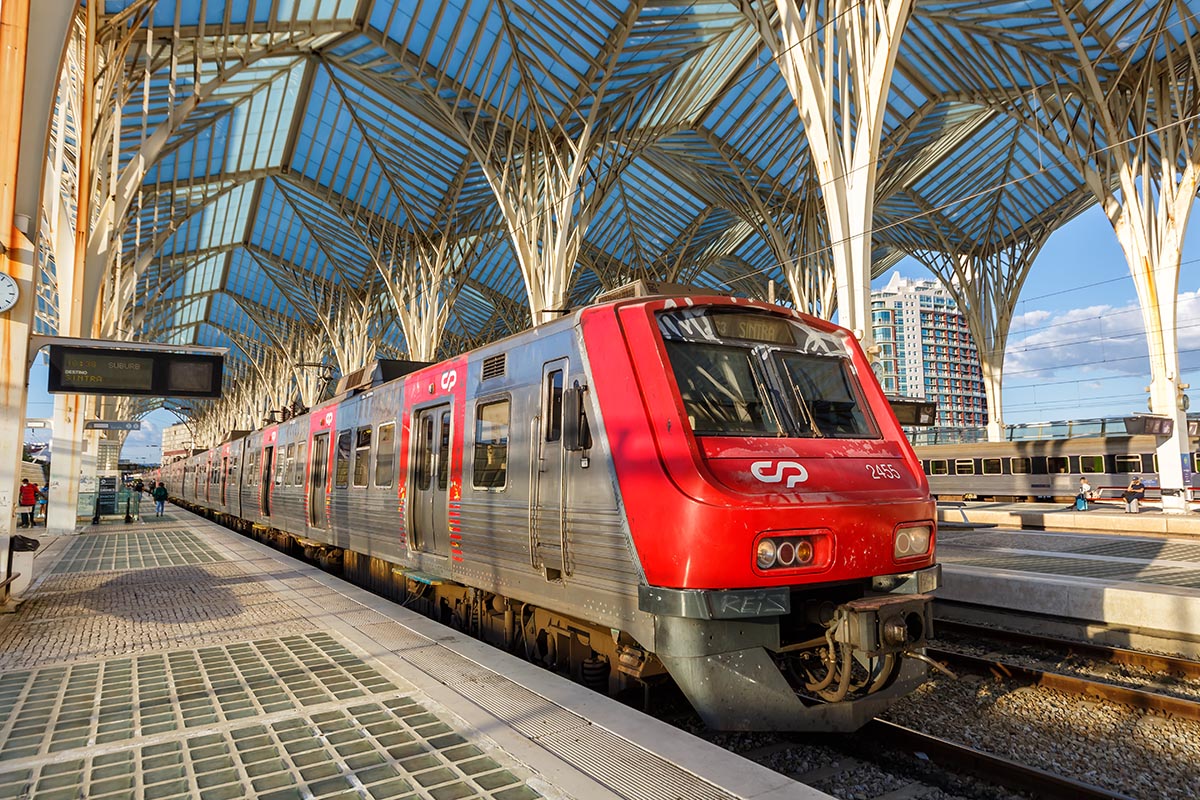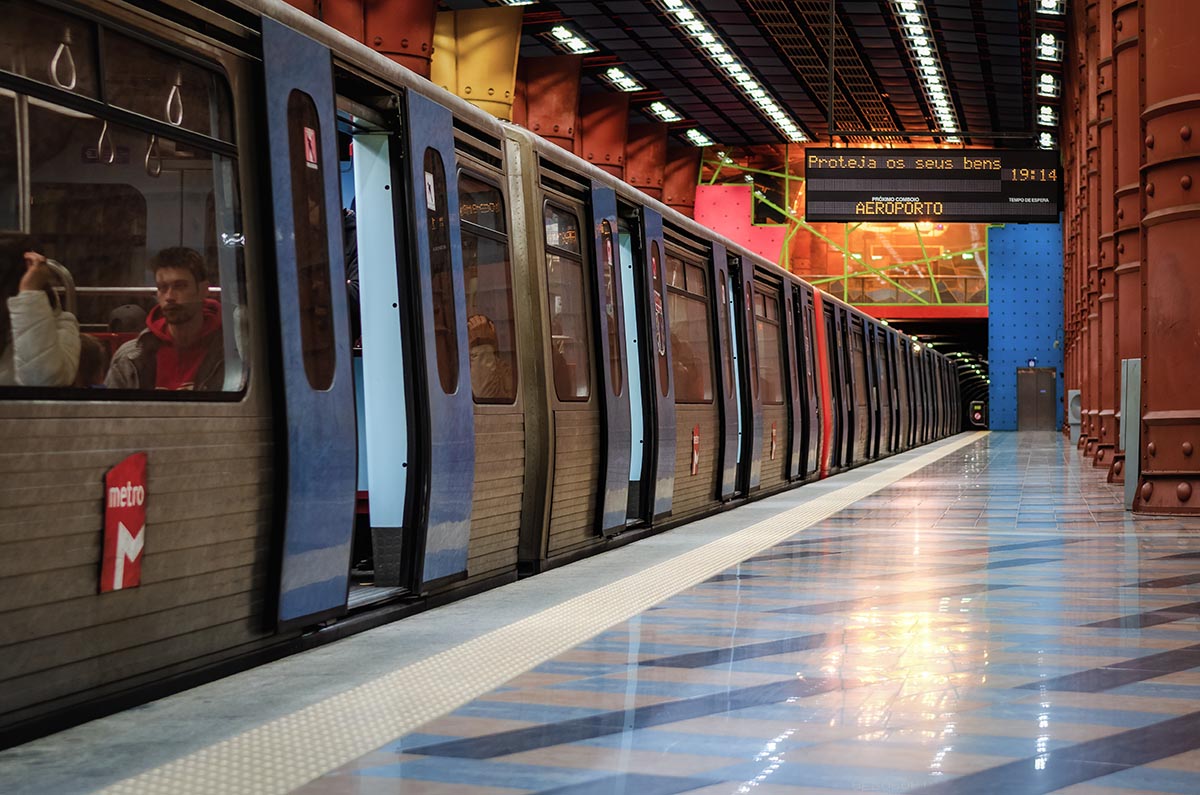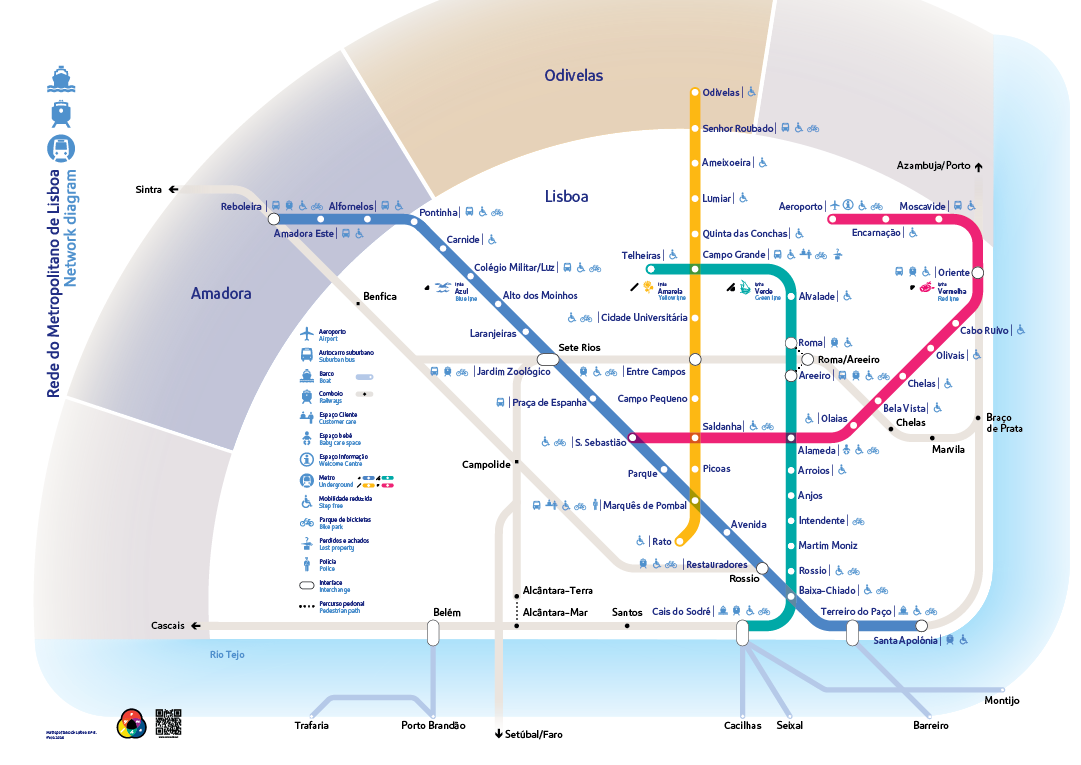
With its blue-flagged beaches, exciting cities, and protected nature parks, picking only one place to visit in Portugal is hard work. Fortunately, the country has an excellent and reasonably priced transportation network, and plenty of two and four-wheel vehicle rental options, making getting around this Iberian wonder a breeze.
Here is your guide on how to get around Portugal:
Train

Portugal has a large railway network that spans practically the whole country, making travel between the cities very economical, extremely convenient, and oftentimes very scenic, thanks to all the greenery we see when travelling from city to city. Trains connect famous tourist destinations Lisbon, Faro, Lagos, Porto, and Figueira da Foz, while international links run to Paris and Madrid.
In January 2024, the Portuguese Government announced a new High-Speed Rail Line between Porto (Campanhã station) and Lisbon (Oriente station), with an extension of approximately 290 km. The new line will ensure a direct travel time between the two cities of 1 hour and 15 minutes and a significantly increased railway capacity along this corridor.
Developing in multiple stages and originating from Porto, the initial phase is anticipated to conclude between Porto and the city of Soure by 2028. Subsequently, phase 2, linking Soure to Carregado station, is scheduled to be finalised by the end of 2030. Phase 3, extending from Carregado to Lisbon-Oriente Station, will be carried out until 2030. Prioritising seamless integration with existing rail networks, this new line will serve both upcoming high-speed trains and current long-distance services, assuring heightened connectivity and shortened travel durations.
The initiative shows Portugal's dedication to modernising its rail infrastructure, fostering a more interconnected and efficient future. CP (Comboios de Portugal) is the country's largest railway operator, operating four main categories of long-distance service (international trains not included):
- Regional (R): trains that stop at almost every station in Portugal
- Interregional (IR): faster trains that skip the smallest stations
- Intercidades (IC): express trains that tend to stop only in major cities
- Alfa Pendular Deluxe: faster than express trains, which can also be pricier
- TGV: high-speed train connecting Porto and Lisbon (available in 2030)
Lisbon and Porto each have their own Suburbano (Suburban) railway systems. The Greater Lisbon network extends to Sintra, Cascais, Setúbal, and up the lower Tejo valley. Greater Porto's network stretches to Braga, Guimarães, and Aveiro, bringing the term "suburban" to higher standards. Suburbano services also run between Coimbra and Figueira da Foz.
Long-distance train tickets may be purchased online, at the official Comboios de Portugal website or at stations around Portugal. Tickets for Intercidades and Alfa Pendular are available up to 30 days in advance; however, you should have no constraints reserving for the following or even the same day. Other services must be reserved at least 24 hours in advance to guarantee a ticket.
In October 2024, the new Green Rail Pass, or Passe Ferroviário Verde, was put into effect by the government, allowing Portugal’s residents to take limitless trips on the Regional, InterRegional and Intercidades trains for a period of 30 consecutive days, with the sole cost of 20 euros. There is also the option of buying passes that are valid for 60 and 90 days, costing 40 and 60 euros, respectively. This transport pass is loaded into a CP card that costs 6 Euros. Some suburban trains, like the ones circulating in Coimbra or outside the metropolitan area of Lisbon and Porto are also included in the new pass. However, it requires reserving your seat 24 hours prior to your journey and first-class spots are not included by this option.
It is important to mention that children under 5 can travel for free, and between the ages of 6 and 12 only pay half price. Additionally, senior travellers from 65 and upwards can get 50% off any service but must show ID.
Bus
(7).jpg)
Getting around Portugal by bus is the ideal option for those on a tighter budget. If you wish to get to the smaller towns and villages that are not served by the rail network, you can book your tickets on the following transportation networks:
- Rede Expressos: links the Algarve region to Lisbon, Porto, Barcelos, Braga and Arcos de Valdevez
- Rodonorte: serves the north of Portugal from Vila Real
- Eva Transportes: Algarve regional network, connecting its towns, and with Sevilla (Spain) along the routes
- Frota Azul: gets you around the beach resorts in Portimão
- Gypsyy: Connects Porto, Sintra, Cascais, Lisbon, Albufeira and Faro.
- Flixbus: offers low-cost bus travel throughout the country (and also Europe)
- Transdev: Operates from the north of Portugal until the northwest part of Tagus Valey
The bus services fall into 3 main categories:
- Carreiras: daily buses routes with several stops
- Expressos and Rápidas: comfortable and faster buses. Expressos run between major cities and Rápidas within specific regions
- Alta Qualidade: a much faster category offered by some networks
Car and Motorbike

Exploring Portugal on wheels is a wonderful way to experience the country, since it allows you to explore freely without relying on transport and timetables. The country's network of roads and motorways is steadily growing throughout the country. Nationals from the EU, the United Kingdom, the United States, and Brazil require their home driving licence to operate a vehicle in Portugal. Others need to get an International Driving Permit (IDP) from their home country's driving licencing agency.
Renting a car in Portugal is reasonably simple, with rental companies located in major towns, cities, and airports such as Lisbon, Porto, and Faro. Because of competition, prices in the Algarve are usually cheaper, and booking ahead will generally save you money. Among the various automobile rental firms accessible in Portugal are Amoita, Holiday Autos, Gerin, Sixt, Hertz and Europcar.
If you plan to stay in the Algarve, you may want to book a transfer with Portugal Airport Transfer, which uses the best routes available to transfer you to your destination in quality time.
You may also rent motorcycles and scooters in larger cities, and all over the coast of the Algarve.
Bicycle
(11).jpg)
Although there are only a few designated bike lanes, cycling is quite popular around Portugal. The available routes start in the north’s natural parks, for example, Parque Nacional da Peneda-Gerês, along the coast, and also in the Alentejo region. If you are up for a hilly trail, biking in Serra da Estrela (which acts as the Tour de Portugal's "mountain run") is quite a fun challenge. You might also attempt to cycle in Serra do Marão, which is located between Amarante and Vila Real. Cycling in Portugal offers incredible routes, tracks and paths, blissful sights and fascinating landscapes.
Overall, Portugal is a safe country that can be explored on your own - just make sure you have the right bike routes to keep you out of traffic.
Read More:
Portugal Ranked the Best Country for Road Trips in Europe
Cycling your way through Spain and Portugal
EN2: Meet Portugal’s Route 66
Airplane
(8).jpg)
In mainland Portugal, there are three major airports: the Porto airport in the north; the Lisbon airport in the capital, and the Faro airport in the Algarve. The Portuguese archipelagos of Madeira and the Azores also have airports with good infrastructure, the most famous being the Funchal Airport in Madeira, connecting the islands to 65 other airports worldwide, and a capacity to handle approximately 3.5 million passengers annually.
When travelling to another country, the Lisbon airport is Portugal’s main connection point, though flights landing in Porto may occasionally be available at a lower cost.
TAP Air Portugal, the national airline, frequently provides affordable fares and a range of flights, especially when travelling domestically. Among its offerings is the Stopover Programme, which allows travellers who are going to Europe from the United States, Canada, and Brazil to add a free stopover in Portugal for up to 10 days.
Ryanair and EasyJet are two other low-cost carriers that fly to (and via) Portugal.
Lisbon airport is the most convenient departure point for those who wish to travel to the archipelagos of the Azores and Madeira, with flights to Ponta Delgada (São Miguel), Lajes (Terceira), Horta (Faial), and Santa Cruz (Madeira). A journey that can last anywhere from 1.5 to 2.5 hours, depending on the island you are flying to. If you prefer to fly on private jet charters, Portugal has many dedicated airfields that help save time and allow you to arrive closer to your destination. The most well-known will be the Lisbon Tires Cascais Airport, and Sintra Airport which are within proximity to both Lisbon, Cascais and the Sintra area.
Other airfield locations offering private charter services within northern Portugal, closer to the city of Porto include Maia Vilar da Luz Airfield, Espinho Airfield, Viseu Airfield, Bragança Airfield, Ovar Airfield, and Monte Real Airfield. In the southern region of Portugal, there are dedicated airfields in Montijo and Sines, which are closer to Lisbon South Bay, and should your destination be closer to Alentejo and the Algarve, you can choose your private charter flight to either Évora, Beja Airport, Alvor airfields, or Faro Airport.
Metro/Subway

Hopping on the Metro/Subway is a great way to get around Portugal within the larger cities, such as Porto, and Lisbon with the Metro Network and through the overground car system in the Lisbon South Bay.
Metro fares are reasonable, and special tour tickets or 24-hour fares ranging from € 5.15 to €16.70 in Porto and from € 6.80 to €10.80 in Lisbon and are available for purchase at vending ticket machines, and through a Metro operator; purchasing a day ticket allows you more freedom of travel especially on the days you feel like exploring more!
Lisbon metro lines
The Lisbon Metro has four main transit lines, connecting the city’s major sections; each line is distinguished by colour and symbol iconography, making it easy to understand for locals and tourists alike.
Linha Azul, the blue line, features a seagull icon, and runs from Santa Apolónia to Reboleira. This metro line is connected to the railway stations of Santa Apolónia and Sete Rios (accessible through Jardim Zoológico metro station). It links major sought-out areas of Lisbon, such as Praça do Comércio (also known as Terreiro do Paço), Marquês de Pombal (that also links to the yellow line), Jardim Zoológico, Colégio Militar and Reboleira, in the parish of Amadora, one of the larger ones within the Lisbon Metropolitan Area.
Linha Amarela, the yellow line, features a sunflower icon, and runs across Rato to Odivelas. This metro line connects to the railway station of Entrecampos. It also links to other important areas of Lisbon, such as Marquês de Pombal (crossing with blue line) Saldanha, Campo Pequeno, Campo Grande, Lumiar, to the northwestern city of Odivelas.
Linha Verde, the green line features a caravel icon and runs across Cais do Sodré to Telheiras. This metro line connects to the railway station of Cais do Sodré, which is a terminus hub for the Cascais train line, and other Lisbon buses and trams. It also connects to a ferry line of the same name, providing access to some key areas in the Lisbon South Bay.
The Green metro line travels through many of Lisbon's downtown hotspots, such as Chiado (in Baixa-Chiado metro station, also connecting to the Blue line), and Rossio, Intendente, Anjos, Arroios, Alameda (which links to the Red line), Areeiro and Roma. The latter two converge at a single railway station – Roma-Areeiro, which enables you to transfer onto the Sintra and Azambuja railway lines.
Fun fact: despite sharing the same name, the Rossio railway station links with the Restauradores metro station, which is in the blue line. The Rossio metro station does not link to either of these but is a short 5-minute walk from both.
Lastly, the Linha Vermelha, the red line features a compass, and runs across São Sebastião to the Lisbon Airport; the São Sebastião station, as a terminus hub, crosses over between the blue and red lines within the neighbourhood of São Sebastião da Pedreira in Avenidas Novas parish.

Source: Metropolitano de Lisboa
Porto metro lines
In the city of Porto, the metropolitan transport has six lines of rapid transit running through the city’s suburbs and central Porto, much like in Lisbon. The network reaches over seven municipalities: Porto, Gondomar, Maia, Matosinhos, Póvoa de Varzim, Vila do Conde, and Vila Nova de Gaia.
Line A, showcased in blue, connects Estádio do Dragão do Senhor Matosinhos; the best-known station for FC Porto all-seater football stadium in Porto, which has the capacity of seating for 50,033 fans. During a soccer match, this station will be buzzing with a heavy traffic of people which makes it easily accessible for those who wish to skip driving to the match altogether!
Line B, showcased in red, connects Estádio do Dragão to Póvoa do Varzim; this transport line connects the busier city centre areas of Porto city, such as Heroismo, Campanha, Trinidade, all the way to Póvoa do Varzim, a city that is 30km away from Porto. Best known for its shipbuilders and merchants, this recognition dates back to the Age of Discoveries, as all grand ships for voyages beyond Portuguese soil were originally built in Póvoa de Varzim.
Line C, showcased in green, connects Campanha - to ISMAI; on this line you begin within a parish of Porto, in Campanha station, considered to be the busiest and one the oldest habited area in Porto, dating back III and II millennia A.C. In Campanha, you will witness grand Quintas (Villas) and palaces, where the Portuguese bourgeoisie once lived. On route towards Line C’s terminus station to ISMAI, which is the University of Maia (Universidade da Maia), a definite busy route for students.
Line D, showcased in yellow, connects Hospital de São João to Santo Ovídio; this line connects you to Porto’s main hospital at Hospital Sao Joao, which acts as a medical school as well, giving direct access and assistance to the parishes of Bonfim, Paranhos, Campanha, Aldoar, Maia and Valongo. The terminus stops at Santo Ovidio in Vila nova de Gaia, commonly known as Gaia; a city situated on the south end of Porto, on the other side of the Douro River. Gaia is known to hold many port wine cellars or “caves”, which is a huge touristic attraction.
Line E, showcased in Purple, connects Trindade to Aeroporto; at the modern metro station of Trindade, you are near various hotels in the city centre of Porto, and plenty of local commerce, from restaurants, cafes, shops and cinema. This line is perfect for those who are first visiting the city of Porto as the metro line travels directly to the airport; a great route to and from your selected hotel.
Line F, showcased in orange, connects Fânzeres to Senhora da Hora; this line connects the parish of Fânzeres in Gondomar, just outside of Porto where you witness beautiful architectural landmarks and quintas from the 18th century. Its terminus stop is in Senhora da Hora, a parish in Matosinhos, part of greater Porto, which is famously known for having the second largest shopping mall in Portugal at NorteShopping.

Source: Metro do Porto
Tram
(10).jpg)
Taking a ride on one of Portugal's historic trams has become one of the country's must-have experiences. These lovely rattling antiques roll through the small alleyways of Lisbon and Porto, providing a low-cost sightseeing tour of both cities. As a result, they frequently become quite crowded at the height of summer - get there early in the morning to ensure a seat!
In Lisbon, Tram 28 is the most famous, which is the best way to get to know the city as it passes through the popular tourist districts, from the starting route at Martim Moniz to Campo de Ourique. You can experience the districts of Graça, Alfama, Baixa, and Lapa-Estrela; each distinct with its own charming character, architecture, and national landmarks.
The route of Tram 12 will begin at Praça da Figueira, one of many busy squares in the city centre of Lisbon, known as Baixa, showcasing an equestrian statue of King João I in the middle. That tram line will take you up and back from São Jorge Castle, giving your legs a chance to rest from the cobblestone streets.
Now, if you are in the Cais do Sodré area, you will find that this is a main connection for trains towards Cascais, and ferries to the Lisbon South Bay. Here you can hop on Tram 18 which will take you towards Ajuda, a neighbourhood situated above Belém district, where you can get a chance to witness Palácio Nacional da Ajuda, a Portuguese royal palace turned into a museum.
On Tram 24 you can venture from Largo do Camões to the heart of Campolide, passing through a sought-after neighbourhoods like Príncipe-Real, Rato, and Amoreiras. Príncipe Real is a great stop to hop off Tram 24 to enjoy this beautiful spot in Lisbon that offers a multitude of restaurants, bars, and alternative boutique shops.
Another tram route to experience when in Lisbon is Tram 25, which connects Praça da Figueira to Campo de Ourique, passing through the neighbourhoods of Santos, and Lapa-Estrela, where you can hop off to visit the Basílica da Estrela and the Museum of National Ancient Art.
In Porto, vintage tram transportation is also highly popular among locals and tourists; there are three main tram lines connecting the city within a 30-minute ride, and fares can be purchased onboard with the driver at €6 (updated in October 2024).
Catch a ride on Linha 1 (Line 1) cable car, the most popular with tourists when visiting Porto, venturing your way through the northern bank of the Douro River from Infante, via Alfandega and Massarelos, to Passeio Alegre in Foz do Douro. This route is an especially pleasant way to see the beautiful Douro River, showcasing amazing views from the tram while soaking up the charm Porto has to offer.
On Linha 18 (Line 1), the route connects the parish of Massarelos, where the Tram Museum is located, making your way through Rua da Restauração with Carmo (Praça Parada Leitão), next to the rectory of the University of Porto. Massarelos parish is classified as a UNESCO World Heritage Site, as it is considered Porto’s olden downtown area with a 2,000-year-old history.
On route at the cable car Linha 22 (Line 22), starting at Carmo and Praça da Batalha with the Funicular dos Guindais, which offers convenient transport connections to three stations on the Porto Metro. Batalha Square is considered an important monument of the late 18th century in Porto, showcasing the city’s opera house, the Royal Theatre of São João, and Cinema Batalha, making it a busy hub offering plenty of cafes, restaurants, monuments, and hotels.
Funiculars or Elevators
(15).jpg)
In Lisbon, there are three funiculars, also referred to as cable cars, lifts or elevators, that are considered national treasures, and help you get around the city of eights hills. They are the Gloria Elevator, the Lavra Elevator, and the Bica Elevator.
A one-time use ticket costs €4.10 (price in October 2024), directly at the funicular. There are also 24-hour tickets which can be purchased at metro stations, either through a ticket vending machine or via an operator. This option allows you to hop on and off as many times as you like on the metro, trams and buses.
The Gloria Funicular can be caught at Avenida da Liberdade, by Praça dos Restauradores taking you up to Bairro Alto, Príncipe Real neighbourhood, and witness amazing views of the city at the garden and lookout point of São Pedro de Alcântara.
Lavra Funicular connects Largo da Anunciada to Rua Câmara Pestana, in the parishes of Santo Antonio and Arroios; within proximity, you can visit Jardim do Torel to experience a public park with great water and city views, and the Campo Mártires da Pátria public park.
Lastly, the Bica Elevator connecting Rua de São Paulo with Calçada do Combro and Rua do Loreto; leading you to Bairro Alto, and Bica neighbourhoods, and best of all, the lookout point known as Miradouro de Santa Catarina, part of the eight hilltops or “Colinas” of Lisbon.
Note that there is a 4th lift in Lisbon, in fact a very famous one: the Elevador de Santa Justa. Connecting Ouro Street to Largo do Carmo, this historical and beautiful monument currently serves more as a tourist attraction than as a mean of transportation and the ride up and down costs €6.00 (price in October 2024).
Getting around Portugal is quite easy; there are plenty of options for those who might not wish to rent a car and drive. Ultimately, public transportation services in Portugal are trustworthy and affordable, especially when you are visiting this beautiful country!
Read More:
Most Beautiful Places in Portugal
Porto and Lisbon are the friendliest cities in Europe
The Best Time to Visit Portugal: According to Attractions, Locals and Experts
Regions of Portugal: There Is More to Visit Than You Think














